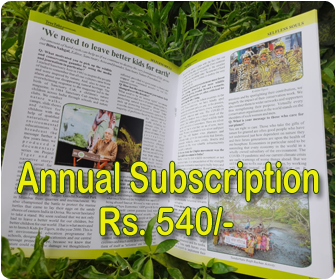Selfless Souls
Dr Yashpal Singh is the Chairman of The Wealthy Waste School India and a former Director of Environment in the Government of UP…
Q: Do you agree that robust governance, rather than just technology, is crucial for meeting environmental standards? Please elaborate.
While technology and governance are complementary and very important in achieving the ends of sustainable environmental management, I would feel that, in terms of meeting environmental standards, which are real-time responsibilities, governance has a more important role. The standard setting process takes into account the available waste management technologies and the carrying capacity of recipient systems. The regulatory regime leaves little option except to comply with these prescribed standards based on best available technologies. Nevertheless, I would feel that technology upgradations are always needed for better resource use efficiencies and waste minimisation. Technology would also come into play if a regulation sets a future date for compliance with standards or if an entity wants to go beyond standards. Production technologies may also need to innovate for better per product unit resource utilisation efficiencies, reduction of waste, and for meeting the ends of the circular economy. This may not need statutory governance by regulatory bodies, but an internal will and culture within an organisation to go beyond compliance, and would help organisations and regulatory bodies in evolving future strategies for better environmental management.
Q: In your view, what are the biggest gaps in India’s current environmental governance framework, and how can they be bridged?
I would think that the environmental governance framework would considerably improve if we were more focused. Currently, we may be spending 80% of our resources to solve 20% of the problems. It would do better if the Pollution Control Boards ceased to work only as Industrial Pollution Control Boards, and all other departments also followed suit. Industry has a limited role to play in terms of its contribution to overall environmental protection. Source apportionment studies have indicated that in cities like Kanpur, in terms of air pollution, only 9.45% is contributed from Industry, and in Delhi city and NCR towns, the contribution from industrial sources was only between 10 to 15%. It is high time that we also pay a little more attention to managing the non-industrial causes of environmental degradation, including the growing population, urban congestion and scarcity of resources, and the lack of supporting infrastructure. Carrying capacity estimates are important. We should realise that the world is short of resources. The more we grow, the greater the requirement for goods and services, even for basic existence. The world has a very high ecological footprint (2.6 Global Hectares), far exceeding its biocapacity (1.5 Global Hectares). It is already consuming the renewable resources of 1.7 Earths. At the present level of consumption and waste generation, India requires the resources of 0.7 Earths, which is 70%. With a reduced water availability of 1341 cubic meters per capita in 2025, as against an availability of 5177 cubic meters per capita in 1951, the world is water-stressed. Water stress occurs when water availability falls below 1700 cubic meters per capita per annum. I hope we understand. I would also feel that much improvement is needed in the environmental clearance process, both in terms of the diligence of appraisals, the quality of E.I.A. reports and the credibility of data. In order to achieve a better utilisation of manpower resources, it is important for regulators to differentiate between critical, serious, and not so serious noncompliance from within the hundreds of conditions that industry is expected to follow. This focus will help environmental governance to a great extent by facilitating the use of scarce resources judiciously for critical issues.
Q: How do you see the role of decentralisation, empowering local bodies and communities, in effective environmental management?
A considerable amount of decentralisation is already there. We may only need to ensure that we carry out our responsibilities judiciously. The regulatory framework for environmental management is fairly decentralised, with the states administering the pollution control laws, parts of the Environment Protection Act and the Forest Conservation Act, the Biodiversity Conservation Act, the Ground Water Regulation Act, etc. Local bodies and communities have been entrusted with responsibilities in waste management. It has to be remembered that for regulation, local bodies and communities are polluters also and therefore they need to address this in a more responsible manner. Almost 80% of pollution inherent on rivers is due to untreated or partly treated municipal wastewater. Both local bodies and communities should focus on minimising and treating these wastes. Decentralised treatment plants and recycling treated wastewater in flushing may not be the ideal solution. I have seen the values of property falling drastically because of odours arising from ill-managed decentralised treatment plants or sewage pumping stations in the heart of the cities. Common municipal treatment facilities may have to be supported. The community may wish to segregate waste at source and contribute to the ‘Waste to Wealth’ initiatives. This is lacking.
Q: What are the key challenges in ensuring compliance with environmental regulations in industries, and how can enforcement be strengthened without stifling growth?
I would feel that the most important action towards ensuring compliance with environmental regulations is to foster a regime where conservation is retained as a culture. India has always been known for it. Fear promotes evasiveness and false reporting of compliance. It has to be realised that compliant environmental management generates profits and welfare. Within the segments contributing to environmental impacts, organisations have to generate a will to examine and comply with their obligations judiciously. Regulation is very clear. Environmental standards have to be complied with. There is no escape. The compliance assurance mechanism in enterprises may have to be strengthened by shared responsibilities, better coordination between the production and the environmental management divisions of an organisation and delegating specific responsibilities of compliance to vendors and also amongst various employees of an organisation and reviewing them periodically. Enterprise should now stop regarding environmental management as an externality.
Q: What is your concept for generating wealth from waste that offers solutions for solid waste management issues?
Waste presents a high potential for generating wealth. I feel that waste-to-energy, bio-methanation, bio-remediation, materials recovery, composting and co-processing are potential areas. Various government schemes provide economic assistance.
Q: How do you envision the role of the circular economy in addressing India’s waste crisis? Can you share some successful case studies where scientific waste-to-wealth models have been implemented effectively?
The traditional linear economic model was based on take, make, consume, and throw away. It put increasing pressure on resources and created difficult-to-manage, adverse environmental problems, including increased challenges in waste management. The shift is now towards the circular economy, which is based on reuse and recycling, maximising resource use and minimising waste generation in order to reduce pressures on the environment and to ensure an enhanced supply of raw materials. It also aims at utilising the waste to generate wealth to the extent possible. The aim is to enhance the life cycle of a resource to the maximum extent possible. Though India also followed the traditional linear economic model, the Indian pattern of consumption always disfavoured the consume and throw away model. We have always found a use for throwaways and wastes. One of the best examples of the circular economy is the sugar-distillery complex. Sugar mills in manufacturing sugar produce molasses as waste, which is utilised by distilleries to produce alcohol, including ethanol. Distilleries produce spent wash as waste, which is used in the production of biogas, and together with press mud, produces bio-compost. Spent wash may also be incinerated to produce power and potash, and this finally has the potential to ensure a zero liquid discharge. There has been a considerable reduction in water consumption and wastewater discharge per unit product over the years. Treated sugar condensate water is also being used by the attached distillery complexes. Some other examples of circular economy are fly ash bricks, Portland cement blended with 30% fly ash from power plants, pozzolana Portland cement using steel slag waste, and the coprocessing of organic waste as fuel in furnaces, incinerators, and boilers. The circular economy does offer economic solutions to waste management.
















Leave a comment